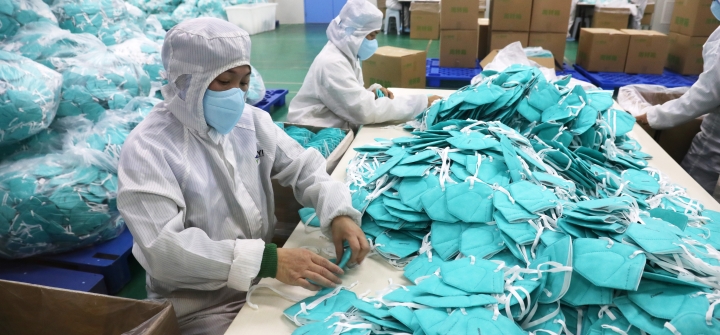We Know How to Prevent the Next Pandemic—But It’s Easier Said Than Done
“The window of opportunity for enhancing pandemic preparedness is rapidly diminishing,” according to a new report from the Council on Foreign Relations.
In Negotiating Global Health Security: Priorities for U.S. and Global Governance of Disease, authors Yanzhong Huang and Rebecca Katz offer a primer and a host of policy recommendations to prevent the next pandemic through three key areas: promoting public health capabilities, bridging the gaps in global health governance, and effectively mitigating the harmful effects of geopolitical tensions.
Many of these approaches have been well-known in the small field of global health security for decades—the bigger challenge is getting them funded and implemented, say Huang, a senior fellow for global health at CFR, and Katz, director of the Center for Global Health Science and Security at Georgetown University.
They spoke to GHN about why pandemic preparedness remains elusive—even when the path to achieving it is well-understood.
Where does the world currently stand in terms of achieving pandemic preparedness?
Yanzhong Huang: There have been important strides. There’s the pandemic preparedness treaty currently in the works, the building of a pandemic intelligence hub in Berlin, a new pandemic fund at the World Bank, and the 100 Days Mission to come up with a vaccine within 100 days of discovering a novel pathogen.
But at the same time, international society seems to have become even less cooperative than before the COVID-19 pandemic, in preparing for the next one.
Why is that?
Yanzhong Huang: With the acute phase of COVID-19 over, psychologically people just want to end this traumatic chapter.
And in the meantime, we have all the other things that need to be prioritized: The crisis in Ukraine, inflation, recession, climate issues, and now, of course, the conflict the Middle East. All of this makes talking about preparing for next pandemic so unpopular—even though we are desperately not ready for the next pandemic. We could repeat the same experience we had with COVID-19.
As leaders in global health security who focused on this issue well before the pandemic, how does that feel?
Rebecca Katz: The global health security field—which is quite small—was largely aligned on what needs to be done for pandemic preparedness, even before COVID-19.
The contributors to the emergence of infectious diseases are not unknown. In fact, we now have more of the things that increase the chance of another pandemic, such as urbanization, climate change, land use changes, and conflict.
During the pandemic, decision-makers and the general public were asking: ‘Why don’t we have this policy or that asset?’ It’s not because we didn’t know we needed it. It’s not because we didn’t know supply chain and manufacturing was important. You just couldn’t rally the political interest and will and finances to get it done.
There’s been lots of high-level, high-profile talk about pandemic preparedness—where is that leading?
Rebecca Katz: There are some important things going on—but there are also missed opportunities. For example, there was a major political meeting at the UN General Assembly. There were hopes that heads of state and ministries of foreign affairs would attend, but largely it was just ministries of health. The resulting resolution doesn’t commit to anything significant. It didn’t seize the opportunity to use the instruments of the UN to form the types of multilateral collaborations we need to address transnational threats to health.
Your report offers wide-ranging recommendations, from biosafety to climate to surveillance. But diplomacy and international collaboration underpins so much of it…
Yanzhong Huang: Global health is a multi-disciplinary field, so we need to take a multi-sectoral approach.
That includes mitigating the harmful effects of geopolitical rivalries. We need serious efforts to reduce geopolitical tensions and create an atmosphere that’s conducive to cooperation. This includes things that may seem, on the surface, irrelevant to global health—such as, with U.S.-China relations, removing the tariffs imposed under President Trump, or reducing tensions on the Taiwan Strait. But that could reduce overall tensions—and create an atmosphere of cooperation around global health security.
To reach meaningful agreements on things like the Pandemic Accord, what does the dialogue look like between LMICs and wealthy countries?
Rebecca Katz: Many countries are questioning the effectiveness of the multilateral system.
Some countries have good reasons for that—particularly those that didn’t get COVID vaccines in a timely manner. Now, they’re trying to figure out how to move forward, and whether the best way to do that is through regional efforts as opposed to or in addition to global efforts.
These issues are currently being negotiated in discussions over the Pandemic Accord treaty. Meanwhile, wealthy nations are trying to figure out how to build systems that collect information faster, and the LMICs are putting much heavier emphasis on their response.
For example, if a country shares its genetic sequence data, do they get access to medical countermeasures faster than another? A lot of countries that feel like they were not treated fairly during the pandemic, particularly on that point, are now being very vocal about that—as they should.
There’s no easy answer on this. Equity is important. But the question is, how do you operationalize equity? It’s messy. This is the third rail of global health security: Who has access and who benefits—who gets what in the system?
*This interview has been edited for length and clarity
Join the 50,000+ subscribers in 170+ countries who rely on Global Health NOW summaries and exclusive articles for the latest public health news. Sign up for our free weekday newsletter, and please share the link with friends and colleagues.
Employees work on the production line of N95 facemasks at a factory on December 8, 2022 in Xuchang, Henan Province of China. Niu Shupei/VCG via Getty Images





